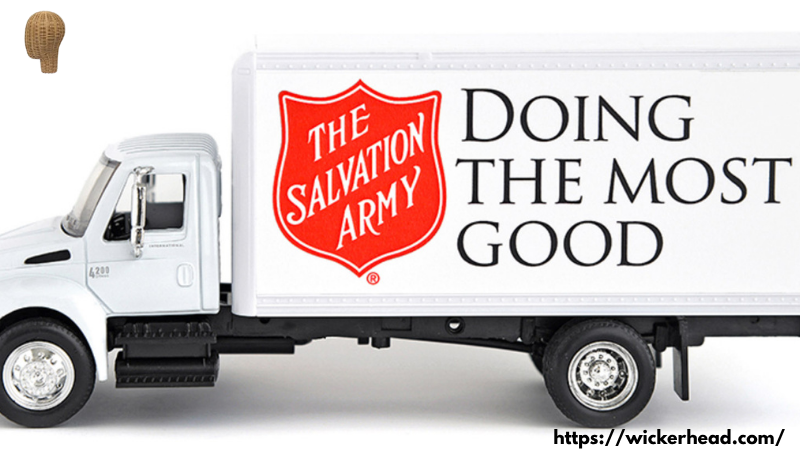Will Salvation Army pick up heavy furniture? It’s a common question from homeowners, renters, and downsizers who want to donate large items without the hassle of moving them. The good news is: Yes, in many cases, The Salvation Army does offer pickup services for bulky furniture donations. However, there are conditions and regional policies to be aware of. In this guide, you’ll learn how their pickup service works, what they will and won’t take, and what to do if your furniture isn’t eligible.
Table of Contents
1. Does the Salvation Army Offer Free Pickup?
Understanding the basic logistics of how their pickup service works will help you plan your donation better.
Free Pickup in Most Areas
The Salvation Army typically offers free pickup services for donated furniture, including heavy items, especially in major cities or areas near their donation centers.
Online or Phone Scheduling
You can schedule a pickup by calling your local Salvation Army or using their online tool, which asks for item type, location, and preferred pickup date.
Based on Zip Code
Pickup availability depends on your zip code. If you’re too far from a regional hub, they may not offer pickup or might require drop-off.
Pickup Timing
Pickup is usually scheduled a few days in advance and is done curbside, meaning items must be ready at ground level or outside if possible.
2. What Kind of Heavy Furniture Will They Accept?
There are guidelines for what types of large furniture items are accepted by Salvation Army drivers.
Couches and Sofas
Most upholstered couches in usable condition are accepted, especially if they’re clean and free from rips or stains.
Dressers and Cabinets
Solid wood furniture like dressers, wardrobes, and storage cabinets are often accepted as long as drawers work and nothing is broken.
Beds and Mattresses (with conditions)
Some locations accept bed frames but do not accept mattresses due to hygiene regulations. Call ahead to confirm.
Dining Tables and Chairs
Large dining tables, chairs, and sets are often picked up as long as they’re not severely damaged or missing parts.
3. What Heavy Furniture Items Might They Refuse?
Not all furniture qualifies, even if it’s in decent shape. There are limits based on logistics and health concerns.
Heavily Damaged Items
If the furniture has major structural issues—like a broken leg or collapsed frame—it will likely be refused.
Items with Mold or Pests
Any sign of mold, mildew, or pests (bedbugs, termites) will result in automatic rejection.
Extremely Large Sectionals
If it takes multiple people or special equipment to move the item, it may exceed their pickup limits.
Built-in Furniture
Fixed or mounted items, like wall-to-wall shelves or custom cabinetry, are not eligible for pickup.
4. Preparing Your Furniture for Pickup
Making things easier for the donation team helps ensure the pickup happens without issues.
Clean the Surfaces
Wipe down wood or leather surfaces. For fabric items, vacuum and remove visible dirt or pet hair.
Disassemble if Necessary
If it’s easy to do, take apart beds or large tables to make transport easier. Keep screws and bolts in a labeled bag.
Place in Accessible Area
Items should be on the ground floor or outside your home, such as on the porch or driveway, if possible.
Inform About Stairs or Elevators
If pickup requires staircases or tight elevators, notify them in advance—they may need to bring extra helpers or decline.
5. How to Schedule a Salvation Army Furniture Pickup
The process is straightforward if you follow these steps.
Step 1: Visit Their Website
Go to the official Salvation Army pickup site: https://satruck.org
Step 2: Enter Your Zip Code
The tool checks whether pickups are available in your area and gives an option to proceed with scheduling.
Step 3: Describe the Items
Be specific—mention type, condition, and size of the furniture. Honesty avoids issues on pickup day.
Step 4: Choose a Time Slot
Select your preferred date. Some locations offer morning or afternoon windows.

6. What Happens After Pickup?
Once the item is picked up, it’s either donated or resold through their charitable network.
Delivered to Donation Centers
Furniture in good shape is taken to local Salvation Army Family Stores or shelters.
Items Are Cleaned or Repaired
Light refurbishing is sometimes done before resale or donation to families in need.
Used to Fund Programs
Proceeds from sales of donated items help fund addiction recovery, homeless services, and job training programs.
Tax Deduction Receipts
You’ll often receive a donation receipt you can use for tax deduction purposes, depending on your country’s laws.
7. Alternatives If Salvation Army Won’t Pick It Up
If your item is refused, don’t worry—there are other ways to pass it on.
Local Donation Centers
Try Goodwill, Habitat for Humanity ReStores, or local shelters—many also offer pickup for large furniture.
Give to Neighbors or Students
Use apps like OLX, Facebook Marketplace, or WhatsApp neighborhood groups to give away the item.
Post on Freecycle
The Freecycle Network connects people who want to give and receive usable goods for free, including furniture.
Upcycle or Repurpose
Even if it’s not fit to donate, you might repurpose old wood or parts—check DIY ideas at WickerHead.com for home reuse inspiration.
8. Can You Donate Furniture That Needs Minor Repairs?
Yes, but only under certain conditions.
Minor Scratches Are Okay
Surface wear and tear like light scratches, small stains, or chipped paint are usually acceptable.
Broken Frames Are Not
If the core structure is damaged—like a broken recliner mechanism or split wood—the item won’t be accepted.
Must Be Safe to Use
The piece should not pose a hazard to users—sharp edges, mold, or sagging parts are dealbreakers.
Honesty Is Best
If in doubt, send a photo or call your local center to check whether your piece qualifies.
9. Environmental Impact of Donating Heavy Furniture
You’re not just clearing space—you’re doing the environment a favor.
Reduces Landfill Waste
Furniture is one of the largest contributors to landfill volume. Donating extends its life and usefulness.
Saves Resources
Manufacturing new furniture uses wood, energy, and chemicals. Donating delays this resource use.
Encourages Circular Economy
By donating, you keep items in use longer, reducing the need for new production and minimizing waste.
Supports Social Causes
Instead of going to a dump, your furniture supports programs for those who truly need a second chance.
10. What If You Can’t Wait for a Pickup?
Sometimes you need to move furniture fast. Here’s what you can do.
Drop It Off Yourself
If you have access to a vehicle, you can drop items directly at a local Salvation Army store or warehouse.
Use a Junk Removal Service
If your furniture isn’t in good shape, services like 1-800-GOT-JUNK will haul it away, often for a fee.
Sell or Give Online
List the item as “free for pickup” on Facebook Marketplace, OLX, or Quikr.
Check Local Churches
Many community churches and organizations have pickup services for families in need—call and ask.

FAQs About Salvation Army Furniture Pickup
1. Will Salvation Army pick up a heavy couch or recliner?
Yes, if it’s in usable condition and accessible at ground level. They may refuse if it’s too damaged or infested.
2. How far in advance do I need to schedule a pickup?
Usually 3–7 days in advance. Popular areas may book faster during weekends or month-end moving days.
3. Can I get a tax deduction for my donated furniture?
Yes, they usually provide a receipt. The value is based on fair market value, not the original price.
4. Does Salvation Army charge for pickup?
No, their pickup service is typically free. However, donations of any kind are appreciated.
5. What if I miss my pickup appointment?
You’ll need to reschedule. Some centers may charge a small rebooking fee or restrict future scheduling.
Conclusion: Will Salvation Army Pick Up Heavy Furniture? Yes—With the Right Prep!
So, will Salvation Army pick up heavy furniture? In most cases, yes—as long as the item is clean, functional, and located in an accessible area. It’s a great way to clear space responsibly while supporting meaningful causes. From couches to dressers, your old furniture can help someone in need or fund a recovery program. Always check local rules, confirm availability, and prep your items for pickup. And if your furniture isn’t eligible, consider repurposing it or browsing upcycling ideas at WickerHead.com for a new life in your home.
